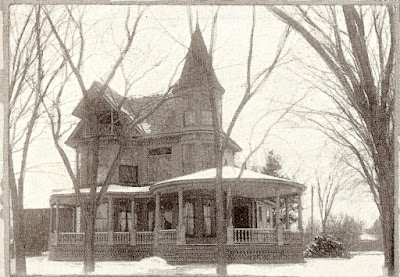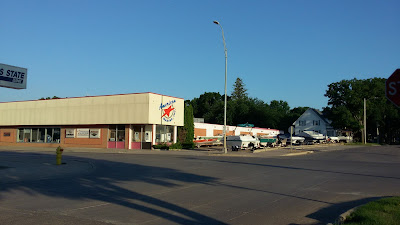When
thumbing through a scrapbook belonging to the Kossuth County Genealogical
Society, a news clipping of George Galbraith and his store caught my eye. It appeared that he had been a leading
merchant from the time of his arrival in 1870 until his passing at the age of
81. I knew of the “Galbraith block” in
downtown Algona, but had to admit that I knew virtually nothing about the man
it was named for. I found a few mentions
of him in the 1913 edition of the “History of Kossuth County,” but he seemed a
bit of a mystery man. I put on my
detective hat and went to work.
WHO WAS GEORGE GALBRAITH?
George
Galbraith came to Algona at the age of 21.
By the time he died on July 21, 1930, he had amassed a large fortune and
left an indelible mark on the city which had become his home.
The
son of Scottish immigrants who settled in Wisconsin in 1844, George was born
there on April 2, 1849. George’s
parents, William and Isabella Galbraith, had four other children: Mary, John, Jane and Isabella. When the family moved to Algona in 1870, his
father began farming but also opened a dry goods store in partnership with
George. John eventually replaced his
father in the store, but the two brothers later parted and each ran separate
businesses.
After
moving to Algona, George met Mary Ellen Cordingley whom he married in 1876. The two became more than marriage
partners—Mary ran a millinery department for many years in the Galbraith
store.
THE STORE
The
first Galbraith store was located on Call Street, but as more businesses opened
on State Street, George decided to construct a new building on the southwest
corner of the intersection with Dodge in 1886.
It was the first double front brick store in town. In addition to housing the Galbraith Store, sections
of the building were rented to others such as barbers. In fact, George Galbraith dug a cistern in
the back and had soft water piped into the building for the comfort of the
barbershop customers.
George
and an unidentified woman employee are pictured in the accompanying photo of
the inside of the store circa 1892. You
will note that the woman pictured is seated on a J.P. Coates thread case. The young lady is holding a palm leaf fan
which was the only “air conditioning” available in those days. One can only imagine how warm those sultry
summer days were in those long sleeves, corsets and full length skirts!
Many
bolts of fabric lined the walls and notions of all kinds were sold. Clerks would bring fabric to the piece goods
counter for perusal by customers seated on stools there. The store provided alterations and sewing in
the back.
Women’s
undergarments were sold in the store but were not put on public display. You will see a picture hanging above the
seated woman showing women in the various styles of intimate garments for
customers to use to choose the item needed.
Advertisements
through the years touted the varying supply of dry goods offered by the
“mammoth” establishment including everything from groceries to hats and caps
and boots and shoes. Kerosene lamps are
shown hanging from the ceiling to provide the necessary lighting. It must have been fun to light those each day
when opening the store. Plus there would
seem to be an element of danger with kerosene lamps so close to fabric and
other flammables.
OTHER INTERESTS
George
continued to expand his real estate ownings.
He purchased several properties in the downtown area which he rented
out. Farmland also became an investment of choice. He acquired over a thousand acres, much in
southern Kossuth County. When the
Northwestern Railway built its tracks diagonally through Sherman township, a
station called “Galbraith Switch” was built in Section 9 named for the owner of
the land—to this day that area is known as Galbraith.
Active
in the community from the time of his arrival, George served as the first
treasurer of the town of Algona beginning in 1872. He was a stockholder and director of the
Algona State Bank. He was also instrumental in bringing Swift & Company to
the city by constructing a building for use as their production plant on one of
his many properties.
THE PICTURESQUE GALBRAITH HOUSE
In
1894 George purchased a house and large lot located at 502 East State Street in
Algona. Remodeling soon began. The house was lifted, moved slightly to the
southwest and a new basement excavated.
A new front was constructed expanding the living area which included a
tall turret. A large wrap around porch
was added and its entrance near the front door of the house had an almost
gazebo-like appearance. One can imagine
many lovely hours spent relaxing and entertaining in this outdoor space as the
northwesterly breezes helped to keep the mosquitoes in check.
The
following spring the Galbraiths graded the yard and laid a wooden
sidewalk. The couple carefully preserved
the majestic elm trees which graced the grounds.
The
two enjoyed their roomy new home and celebrated by hosting a large group of relatives at a New Year’s dinner in 1896. No children had been born to them, but they
delighted in entertaining their friends and extended family members. Their beautiful home was featured in
“Picturesque Algona” a few years later and it was their pride and joy.
By
1905 Mary Galbraith was suffering from debilitating asthma. It was recommended that she move to a warmer
and drier climate. The couple then relocated to San Antonio, Texas. It became Mary’s permanent home, but George
traveled back and forth to take care of his business interests. He found managers for the store and
eventually downsized and moved it first to a location farther east on State Street
and then to a site on North Dodge.
After
a few years, he transferred ownership of the house to his brother, John. During his visits to Algona George would stay
with various relatives in the area.
THE
PASSING OF THE GALBRAITHS
By
1930 both Mary and George were in failing health. Asthma had taken a toll on Mary’s body and
she passed away on January 20th of that year. Much of Algona was saddened at the news of
her death as she was well liked and her charming personality made her a social
favorite in her younger days.
George
was too ill at the time to accompany her body back to Algona for burial. Her brother escorted her back where she was
placed in the burial vault at Riverview Cemetery for storage until her husband
could regain his health and travel back to Algona for her funeral. Sadly, that was not to be. State law required that burial take place within
a prescribed time period and so on July 19th Mary Galbraith’s body
was laid to rest. Two days later in San
Antonio, George himself departed his world, bringing his story to an end. He was interred next to Mary a few days
later. His obituary published in the
Upper Des Moines on August 6, 1930, states:
“He was known for his honesty,
integrity and business acumen. He was
always kind to unfortunates often taking tramps home and feeding them from his
own table.”
THE
PROPERTIES TODAY
The
Galbraith house passed to many owners before being purchased in July of 1968 by
William and Arlene Hood. It had served
not only as a private residence but as an apartment house as well. The house was razed to provide space for an
addition to the west side of Hood’s Super Valu store and additional parking which
took place in 1971. The site is now
occupied by American Marine.
Although
much different in appearance today, the Galbraith block still stands as an anchor
in downtown Algona, a legacy to a well-known and well-respected businessman.
Until
next time,
Jean,
a/k/a KC History Buff
If you enjoyed this
post, please don’t forget to “like” and SHARE to Facebook. Not a Facebook
user? Sign up with your email address in the box on the right to have
each post sent directly to you.
Be sure to visit the
KCHB Facebook page for more interesting info about the history of Kossuth
County, Iowa.
Reminder: The posts on Kossuth County History Buff are ©2015-16 by
Jean Kramer. Please use the FB “share” feature instead of
cutting/pasting.










